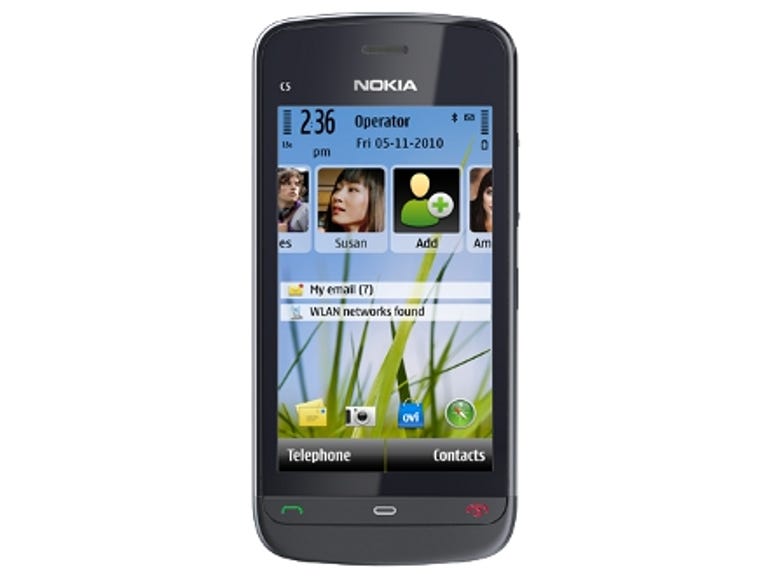 Why You Can Trust CNET
Why You Can Trust CNET Nokia C5-03 review: Nokia C5-03
The Nokia C5-03 is an ill-advised combination of outdated software and under-performing hardware. There are much better mid-range phones available, for less money.
Nokia's recent headline-grabbing shift to Microsoft's Windows Phone 7 platform might have come as a shock to hard-core fans of the Finnish manufacturer. But, after spending a few days with the clunky and disappointing C5-03, it's obvious that change can't come soon enough.
The Good
The Bad
The Bottom Line
The C5-03 is available for £190 direct from Nokia's Web store. Contract prices hover around the £15-per-month mark.
Symbian siblings
Although it shares a similar name, the C5-03 is vastly different to last year's likeable C5 in terms of physical appearance. The alphanumeric keypad has been ditched in favour of a 3.2-inch touchscreen, and the casing is noticeably more compact. Unfortunately, the C5-03's glossy plastic case makes it feel rather cheap and nasty. The slippery battery cover offers little in the way of grip either.

Physical controls are limited to the usual call and end-call buttons, and a menu key sits between them. On the side, there's a volume rocker and lock button, but no dedicated camera key. The lack of physical input options draws attention to the phone's pleasingly large screen.
Touchscreen blues
The 3.2-inch, 360x640-pixel touchscreen uses resistive technology rather than capacitive. It's the cheaper option from a manufacturing perspective, but it requires you to exert slight pressure. Phones like the iPhone 4 and Google Nexus S use the more expensive capacitive type, and, as a result, offer a more accurate and responsive user experience.
A resistive touchscreen just doesn't cut it these days, even at the mid-to-low end of the market. Any argument that the C5-03's touchscreen is acceptable because it's a fairly affordable phone simply doesn't hold water -- we've seen several sub-£100 smart phones with capacitive displays recently, such as the Orange San Francisco.
Ready for the scrapheap
The C5-03's dismal touchscreen has a partner in crime: Nokia's aging Symbian Series 60 operating system. Nokia's recent decision to adopt the Windows Phone 7 operating system has effectively put the final nail in the once-proud S60's coffin. After wrestling with this outdated and infuriating software, you'll be unlikely to shed a tear at the memorial service.
While S60 had its place on the original C5 -- it was equipped with a four-way direction pad for navigation -- it really shows its limitations on a touchscreen device, especially when it's an unresponsive and sluggish touchscreen.
Typing is plagued by lag, and the constant stream of pop-up dialogue windows slows down even the most basic functionality. To top it all off, S60 feels like a relic from the past when it comes to customisation. Budget Android phones will quite happily allow users to tailor their experience, but S60 is painfully limited. Modern smart phones should at least allow you to have more than one home screen, for starters.
Having said that, there are brief glimmers of light amid the stormy clouds of discontent. Ovi Maps is bundled as standard and, once you go through the usual convoluted process of downloading the latest system files, it offers free sat-nav functionality, with turn-by-turn directions. The C5-03's underpowered CPU means the sat-nav is a rather lumbering affair, however. We wouldn't rely on it for last-minute, seat-of-your-pants route planning.
Mystery of the missing multi-touch
The C5-03 offers impressive connectivity, with 3G, Wi-Fi and Bluetooth all present. Sadly, the Web browsing experience is akin to removing your own eyeballs with a rusty tin-opener. Multi-touch gestures are completely out of the question, due to the pesky resistive screen, so don't expect to make any graceful pinch-to-zoom commands. The browser doesn't even have the good manners to reformat pages to suit the screen's size, so viewing your favourite site quickly becomes a tiresome exercise.
In terms of image capture, the C5-03 represents two steps forwards and one step back when compared to the original C5. The megapixel count has risen from 3.2 to 5, but the LED flash has been removed, making low-light shots difficult. We'd have preferred the phone to retain the same set-up as its predecessor, because the extra pixels don't add a great deal to the images produced.
Conclusion
With the war of the budget smart phones set to intensify in 2011, we can't see where Nokia's anaemic C5-03 fits in. There are much cheaper phones available that comprehensively outclass the C5-03, and Symbian is effectively dead. Our fingers are firmly crossed that it's one of the last such handsets we'll see from the Finnish firm. Vote with your wallet and plump for the reasonably priced ZTE Racer instead, or wait for the next generation of budget devices, such as the promising LG Optimus Me P350.
Edited by Charles Kloet


